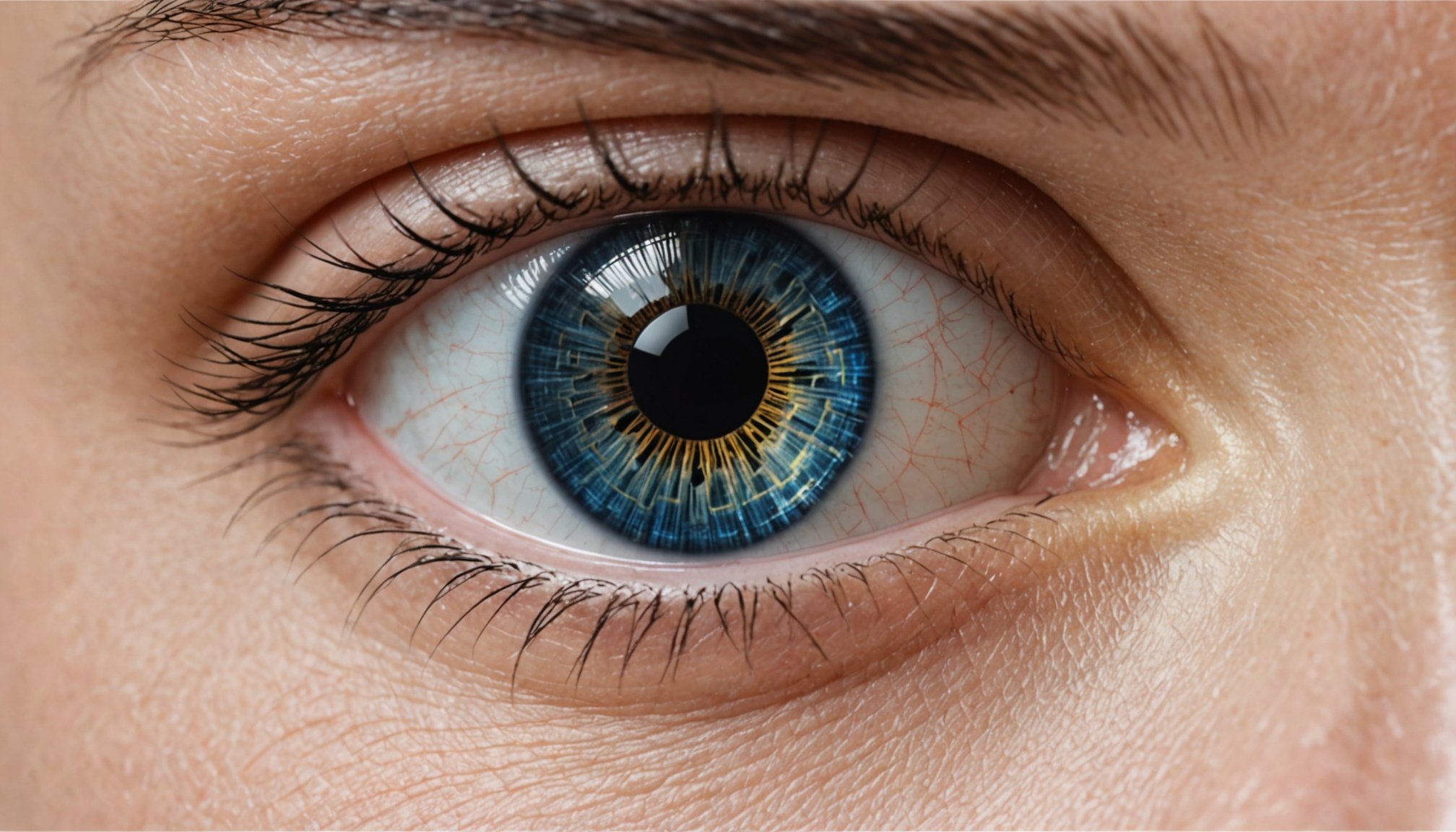Overview of Smart Contact Lens Technology
Smart contact lenses represent a significant advance in wearable health technology, blending cutting-edge components with everyday usability. Their development history is a testament to rapid technological evolution. Originally conceived for aiding vision, smart contact lenses now integrate tiny sensors and microelectronics to monitor health metrics. Such technology marks a shift from traditional devices, offering a seamless and continuous way to track vital signs directly from the eye surface.
Evolution and Core Technology
Early iterations focused on improving visual clarity, but recent advancements have enabled these lenses to collect data related to glucose levels, intraocular pressure, and even provide augmented reality experiences. The core components—sensors, connectivity, and microchips—allow real-time health monitoring. These lenses are equipped with sensors that can detect subtle changes in the body’s chemistry and connect wirelessly to smartphones or cloud storage, ensuring that patients and doctors receive immediate updates.
Have you seen this : Harnessing Computational Fluid Dynamics: Revolutionizing Building Designs for Enhanced Wind Resistance
Comparison with Traditional Devices
Unlike traditional health monitoring devices, which often require multiple steps and physical hardware, smart contact lenses provide a more integrated and less invasive experience. They eliminate the need for cumbersome equipment, harnessing their on-eye positioning to offer natural, unobtrusive data collection. This shift not only simplifies regular health monitoring but also offers an unprecedented level of convenience and accuracy.
Cutting-Edge Features of Smart Contact Lenses
Today’s smart contact lenses are redefining what personal technology can achieve. They come equipped with a variety of innovative technologies that make daily tasks easier and more efficient. At the core, integrated sensors play a crucial role. These sensors can monitor eye health by collecting essential indicators such as glucose levels, delivering real-time health data to users.
In parallel : Innovative Applications of Magnetic Levitation Technology in Next-Generation Transportation Systems
Imagine lenses that not only guide your vision but also keep tabs on your well-being. The real-time data collection and analysis capabilities offered by these advanced features are truly transformative. Immediate alert systems can inform you of potential health issues before they become significant problems, enhancing overall user safety and convenience.
In addition, the user-friendly interfaces integrated into these lenses aim to deliver seamless interactions. Intuitive applications ensure that users can easily access data without cumbersome processes. These interfaces prioritize simplicity, allowing even those who may not be tech-savvy to benefit from the technology.
Smart contact lenses are more than a vision aid. They represent a leap in personal health monitoring. Such advanced features offer users a proactive approach to health, integrating technology snugly into everyday life. Vision correction is now just a part of their capabilities.
Health Monitoring Capabilities
In an era where health awareness is paramount, health monitoring through smart devices has gained significant traction. Wearables now provide users with profound insights into their biometric data, potentially transforming personal healthcare.
Glucose Monitoring
For diabetics, glucose monitoring is crucial. Innovative lenses are emerging as a non-invasive method to track glucose levels in biometric data. By measuring tear glucose concentrations, these smart lenses provide continuous monitoring, simplifying life for diabetics. While current market products are pioneering these advancements, they are still evolving, with room for improvement and expansion in accuracy and efficiency.
Eye Health Tracking
Keeping tabs on biometric data like intraocular pressure can be critical for conditions such as glaucoma. Smart lenses detect changes in eye pressure, offering crucial insights into potential ocular diseases. The technology extends to other eye-related ailments, providing a broad spectrum of monitoring options. Successes in clinical studies point to promising uses in preventive ocular healthcare.
Overall Health Indicators
Beyond specific conditions, smart lenses integrate with other health monitoring devices to form a comprehensive network of biometric data. Monitoring vital signs, such as heart rate and hydration, they provide a clearer picture of overall health. With ongoing development, the fusion of these technologies could significantly aid in disease prevention, marking a transformative shift in proactive healthcare solutions.
Recent Developments in Smart Contact Lens Technology
Smart contact lens technology has advanced significantly, driven by current innovations and substantial industry advancements. There have been notable partnerships between tech giants and healthcare companies, pushing the envelope of what smart lenses can achieve. For instance, collaborations between companies like Alphabet and Novartis have propelled research, aiming to integrate glucose-monitoring functions within the lens. This highlights not just technological possibilities, but also the burgeoning interest in health-focused features.
In terms of material science, breakthroughs have resulted in enhanced comfort and functionality for users. Recent advancements include ultra-thin, biocompatible materials that offer increased breathability and moisture retention. These improvements are crucial, as they ensure that smart contact lenses are not only functional but also comfortable for everyday wear. This marriage of utility and comfort is a significant stride forward for the industry.
On the regulatory front, there is progress towards market readiness. Regulatory bodies are actively assessing smart lenses, with several prototypes already undergoing clinical trials. As companies work to meet safety and efficacy standards, the potential for these lenses to reach consumers increases. Thus, the landscape of smart contact lens technology continues to evolve, leaning towards greater accessibility and integrated healthcare solutions.
Impact on Healthcare
Healthcare transformation has been significantly influenced by technology, particularly in patient management and monitoring practices. One notable advancement is the use of proactive monitoring, which plays a critical role in improving patient outcomes. Through continuous tracking of health metrics, healthcare providers can detect potential health issues at an early stage, facilitating timely interventions and, consequently, better health results.
Implementing proactive monitoring does not just enhance patient outcomes; it also contributes to the reduction of healthcare costs. By identifying and addressing health problems earlier, more expensive treatments and emergency visits can often be avoided, leading to substantial savings. Patients also benefit from reduced hospital stays and improved quality of life.
An essential component of this healthcare transformation is enhanced patient engagement and self-management. With tools that provide real-time insights into their health, patients are empowered to take charge of their wellbeing actively. This engagement encourages healthier lifestyle choices and adherence to treatment plans, fostering a more collaborative relationship between patients and healthcare providers. In this transformative era of patient management, the emphasis on proactive monitoring and patient participation sets the stage for a more efficient, effective, and cost-conscious healthcare system.
Future Trends in Smart Contact Lenses
As emerging trends in smart contact lenses continue to evolve, there is an expectation for significant market growth and increased technology adoption over the next decade. These lenses not only promise enhanced vision but are set to integrate seamlessly with AI and big data analytics. This integration could revolutionize the way we gather and interpret health data, offering real-time insights and personalised health solutions.
While the technology harbours immense future opportunities, particularly in healthcare and lifestyle sectors, potential users must also consider the ethical considerations and privacy issues that come with it. The capability of smart contact lenses to collect and transmit health data raises concerns about data security and user privacy. Therefore, regulatory frameworks need to evolve alongside these technologies to ensure they protect users’ rights.
The future of smart contact lenses looks promising with various opportunities for advancements. As the market grows, they are anticipated to become an integral part of AI-enhanced personal healthcare strategies, facilitating continuous health monitoring with minimal interference in daily life. With proactive solutions and stringent ethical guidelines, smart contact lenses could soon become a common sight in healthcare.
Expert Opinions and Insights
Expert insights and industry perspectives provide valuable context for understanding the future of smart contact lenses. Healthcare professionals express a cautious optimism about their potential. They highlight benefits such as continuous health monitoring and real-time data collection. Nonetheless, concerns about data privacy and potential health risks due to prolonged use warrant further investigation.
Industry perspectives from tech experts in wearables reveal a promising outlook, predicting that smart contact lenses could revolutionize personal healthcare, similar to how wearable fitness trackers have transformed lifestyle monitoring. These experts anticipate advancements in sensor technology and miniaturization, which could enhance the functionality and comfort of smart lenses.
From a user perspective, testimonials emphasize the convenience and innovative appeal of current smart contact lenses. Users appreciate features like glucose level monitoring for diabetics or augmented reality (AR) applications. Yet, they often highlight the initial adaptation period and costs as barriers, which the industry must address for wider adoption.
In summary, while expert insights and industry perspectives shed light on promising opportunities, they also underscore the challenges associated with the ethical implementation and accessibility of these technologies. This highlights the need for a balanced approach, considering both the benefits and potential drawbacks in the evolving landscape of smart contact lenses.











